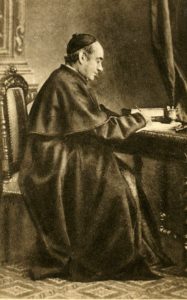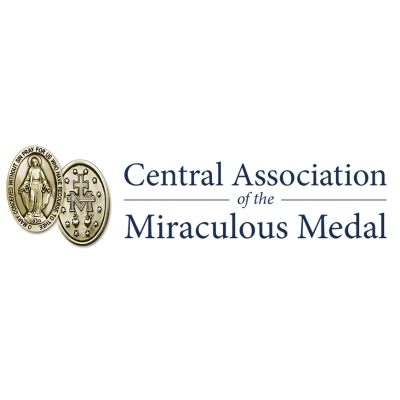Name that Saint: Saint Antonio Claret
A Disciple of Jesus: The Most Famous—and Persecuted—Preacher of His Day
Saint Anthony Mary Claret

Anthony Claret was born in Catalonia, Spain, on December 23, 1807. Two days later, his father went to the parish church early in the morning to have him baptized. With such a momentous christening date, it’s not surprising that at the age of 12, Anthony heard his calling to the priesthood.
Unfortunately, the times were tumultuous, and the government had closed the seminaries. A local priest agreed to teach him Latin, but that didn’t last long. The priest died, and Anthony started working in his father’s textile shop. Extremely talented, Anthony went to Barcelona for further training when he was 17. There, he applied himself fully to his studies—ignoring his calling.
But after a friend betrayed him and he almost drowned, he realized a life of success wasn’t all it was cracked up to be. More important, he knew that Mary had spared his life. Although he was given offers of opening his own textile factory, he walked away from everything in order to become a priest.
At first, he desired to become a Carthusian—and then a Jesuit—but his health prevented him from both Orders. Pursuing diocesan priesthood, he was ordained on the Feast of St. Anthony of Padua in 1835.
It was a politically troubled time, and similar to what happened in France, the ruling party of Spain rejected the Church and its teachings, confiscated its property, persecuted, suppressed, and murdered religious, and did everything it could to stamp out Catholicism.
It wasn’t a great time to be a priest.
But Anthony offered himself and his priesthood to Mary, and soon he was asked to preach missions in nearby villages. He walked throughout Catalonia for five years, preaching missions for priests and laity alike without accepting any payments or gifts for his work. To better help the faithful, he created a publishing house where he printed prayer books and catechisms and distributed them for free during his missions. Through these missions, Anthony quickly became known as “the greatest preacher” of his times, and wherever he went, people returned to the faith. Although his sermons frequently lasted three hours, the churches were packed. When asked what his “secret” was, he said, “I pray to Our Lady and demand results of Her.” And if she didn’t give him what he requested, he would “take hold of the hem of Her robe and refuse to let go until she has granted me what I want!”
The need for preaching missions was great, but priests were few. In 1849, he founded the Missionary Sons of the Immaculate Heart of Mary, commonly called the Claretians. At its very beginning, five other priests joined him.
One year later, the Holy Father appointed him the Archbishop of Santiago, Cuba. His new congregation had just started and his publishing company was still printing books and brochures. The last thing he wanted to do was move, but he reluctantly agreed. It was when he became Archbishop that he added Mary to his name, later saying, “Out of devotion to Mary Most Holy, I added the sweet name of Maria, my mother, my patroness, my mistress, my directress, and, after Jesus, my all.”
Once in Cuba, he discovered a society that was already drastically affected by the Masons. Slavery, exploitation, and anti-Christian ideologies were rampant; even the clergy were not immune to the devastation. Many of them hadn’t been trained well as priests—some hadn’t received the Sacrament of Confirmation. For seven years, he worked tirelessly to rebuild the Church and the society. He created a Seminary; founded religious communities to help teach the faith; and developed farms, schools, and hospitals for the poor. He even started credit unions for the parishes. All the while, he maintained political neutrality, but the Masons plagued him with persecution, slander, and even assassination attempts—one of which permanently damaged his face and his speech.
Obedience sent him back to Spain, where he became known as the “Apostle of the Rosary,” the most famous preacher of his day, and the most persecuted. Assassination attempts and slander continued, but, as always, Mary was with him, and for her, he preached on the power of the Rosary and advocated the dogma of Mary’s Assumption, which would be proclaimed the same year as his canonization.
In 1859, Anthony, who was somewhat of a mystic, was warned by Jesus of three great evils that were descending on the earth: horrible wars; love of pleasure, money, and false reasoning; and a will separated from God. Two years later, Jesus told him that Communism would be “the great foe of humanity. The remedy would include devotion to the Blessed Sacrament and the Rosary.” [1]
With the summer revolution of 1868, Anthony left Spain and went to France, heartbroken. Still pursued and harassed by the Masons, he would never return. He attended the First Vatican Council, but in July of 1870, he suffered from a stroke. Even then, false charges were hurled against him, and his confreres brought him to a Trappist monastery at Fonfroide where he died on the morning of October 24, 1870. It’s said that at the moment of his death, the bells at the Carmelite Convent started ringing on their own.
Anthony Mary Claret was beatified by Pope Pius XI in 1934, and canonized by Pope Pius XII on May 7, 1950. He is the patron saint of weavers, textile merchants, and the Catholic press. His Feast Day is October 24.
“When people love and recite the Rosary, they find it makes them better.” ~St. Anthony Mary Claret
[1] “Our Lady of Fatima and the Fall of Communism” – Craig Turner
Photo Attributions:
BANNER: H. Zell, CC BY-SA 4.0 <https://creativecommons.org/licenses/by-sa/4.0>, via Wikimedia Commons
INSET: Cesc2003, CC BY-SA 4.0 <https://creativecommons.org/licenses/by-sa/4.0>, via Wikimedia Commons
Pray your Rosary with St. Catherine Labouré and Mary’s
Miraculous Medal Family every Wednesday at 2:30 pm (ET).
Don’t have a Rosary? No problem.
We have lovely ones—including a Shrine-Exclusive Rosary—just for you..
Get InSPIREd!
Sign up below and receive our monthly inspirational Newsletter dedicated to Mary!


